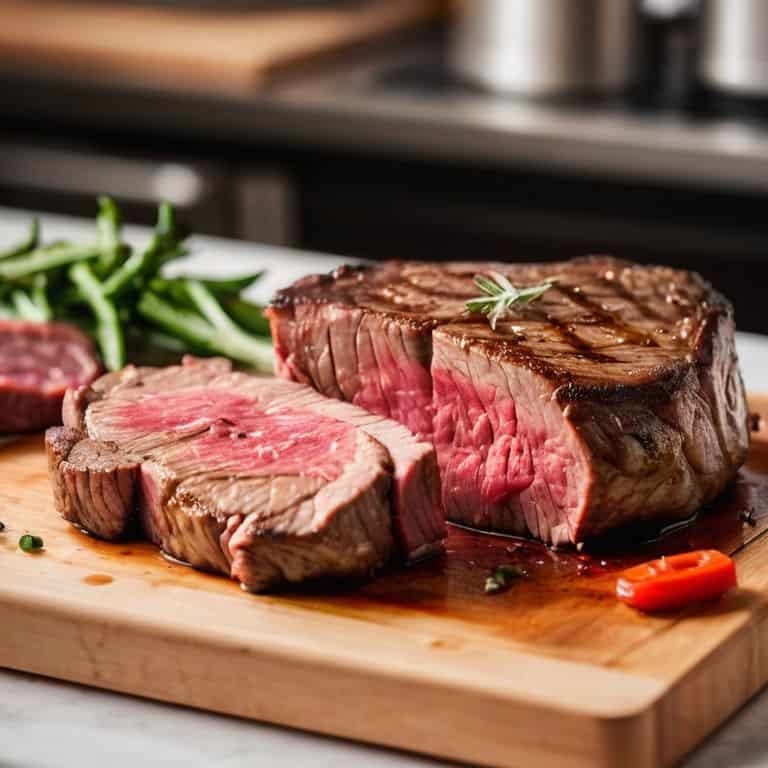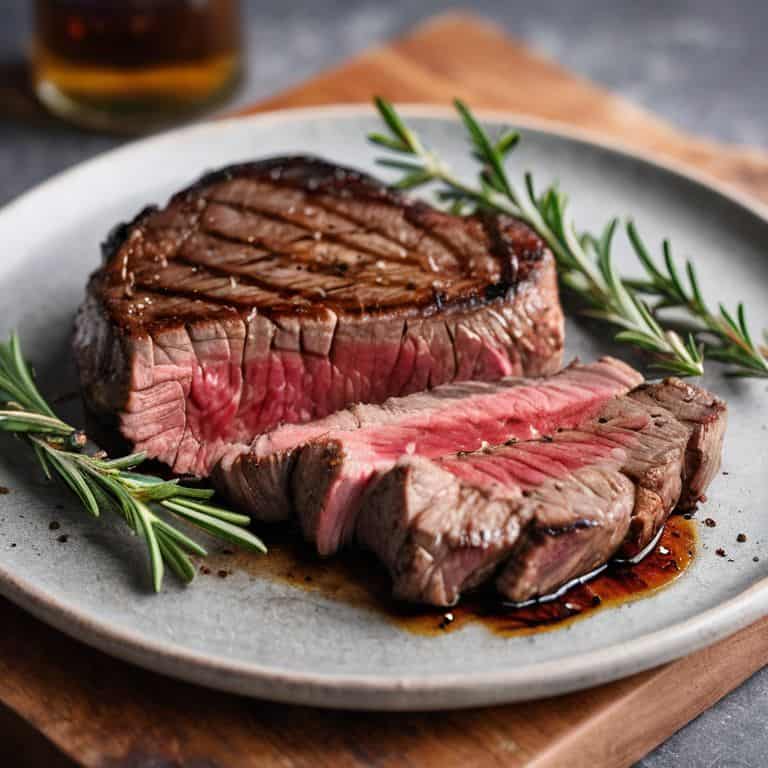As a former bush pilot, I’ve had my fair share of grueling flights, but nothing frustrates me more than a poorly cooked steak. You see, I’ve found that steak cooking temperatures and doneness are not just about throwing a slab of meat on the grill, it’s an art that requires precision and patience. I’ve seen many a pilot, and non-pilot, struggle with getting the perfect medium-rare, only to end up with a charred or undercooked disaster. It’s time to set the record straight and provide a clear guide on how to navigate the complex world of steak cooking temperatures and doneness.
In this article, I’ll share my no-nonsense approach to cooking the perfect steak, every time. You’ll learn how to master the fundamentals of steak cooking, from understanding the importance of internal temperature to selecting the right cut of meat. My goal is to provide you with practical advice that you can apply to your next BBQ or dinner party, so you can impress your friends and family with a perfectly cooked steak. By the end of this guide, you’ll be well on your way to becoming a steak cooking expert, and you’ll never have to worry about serving a subpar steak again.
Table of Contents
- Guide Overview: What You'll Need
- Step-by-Step Instructions
- Mastering Steak Cooking Temperatures and Doneness
- Navigating the Flight Plan of Steak Perfection: 5 Key Tips
- Key Takeaways for Perfectly Cooked Steaks
- Navigating the Skies of Steak Perfection
- Landing Safely: Mastering the Art of Steak Cooking
- Frequently Asked Questions
Guide Overview: What You'll Need

Total Time: 30 minutes to 2 hours
Estimated Cost: $15 – $30
Difficulty Level: Intermediate
Tools Required
- Meat Thermometer (digital or analog)
- Tongs or Steak Turner (for flipping)
- Cutting Board (for resting steak)
- Oven or Grill (for cooking steak to desired temperature)
Supplies & Materials
- Steak of Choice (such as ribeye, sirloin, or filet mignon)
- Olive Oil (for brushing steak)
- Salt and Pepper (for seasoning steak)
- Optional Seasonings (such as garlic, thyme, or rosemary)
Step-by-Step Instructions
- 1. First, let’s get one thing straight – cooking a perfect steak is all about nailing the temperature, so what’s the magic number for a nice medium-rare? To achieve this, you’ll need to preheat your grill or skillet to the right temperature, usually medium-high heat. Think of it like setting your flight plan – you need to know where you’re going before you take off.
- 2. Next, you’ll need to choose the right cut of steak for your meal. I always say, selecting the right steak is like choosing the right aircraft – you need to know its capabilities and limitations. For a medium-rare steak, I recommend a cut that’s at least 1-1.5 inches thick, such as a ribeye or strip loin.
- 3. Now that you have your steak, it’s time to season it for takeoff. Use your favorite seasonings, but keep in mind that you want to enhance the flavor of the steak without overpowering it. I like to use a simple mixture of salt, pepper, and garlic powder. Remember, less is more when it comes to seasoning – you can always add more, but it’s harder to remove excess seasoning.
- 4. With your steak seasoned and your grill or skillet preheated, it’s time to start cooking. Place the steak on the grill or in the skillet and let it cook for 3-4 minutes per side, depending on the thickness of the steak and the heat of your grill. Think of this step like navigating through turbulence – you need to be patient and let the steak cook undisturbed.
- 5. After you’ve flipped the steak, use a meat thermometer to check the internal temperature. For a medium-rare steak, you’re aiming for an internal temperature of 130-135°F. Remember, temperature is key when it comes to cooking a perfect steak – don’t be afraid to use a thermometer to ensure you’re getting it just right.
- 6. Once your steak has reached the desired internal temperature, remove it from the grill or skillet and let it rest for a few minutes. This is like the final approach – you’ve done all the hard work, and now it’s time to let the steak come to a gentle landing. Letting the steak rest allows the juices to redistribute, making it even more tender and flavorful.
- 7. Finally, it’s time to plate and serve your perfectly cooked steak. Slice the steak against the grain and serve it with your favorite sides, such as mashed potatoes or roasted vegetables. Remember, presentation is everything – you want your steak to look as good as it tastes. Take a step back, admire your handiwork, and enjoy the fruits of your labor!
Mastering Steak Cooking Temperatures and Doneness

As we dive deeper into the world of perfect steak cooking, it’s essential to understand the importance of precision when it comes to internal temperatures. A well-calibrated meat thermometer is your best friend in this journey, allowing you to ensure that your steak reaches the perfect level of doneness. Whether you’re a fan of rare, medium-rare, or well-done, having a reliable internal steak temperature guide by your side can make all the difference.
When comparing different steak cooking methods, it’s crucial to consider the unique characteristics of each technique. For instance, grilling and pan-searing require distinct approaches to achieving the ideal temperature. By understanding these nuances, you’ll be better equipped to cook steak to desired doneness every time. Remember, practice makes perfect, so don’t be discouraged if it takes a few attempts to get the hang of it.
To take your steak game to the next level, consider creating a steak doneness chart printable to keep in your kitchen. This handy reference tool will help you quickly determine the perfect internal temperature for your preferred level of doneness. Additionally, don’t underestimate the steak resting time importance, as this crucial step allows the juices to redistribute, resulting in a more tender and flavorful final product. By mastering these techniques, you’ll be well on your way to becoming a steak cooking expert.
Calibrating Meat Thermometers for Perfection
To ensure accuracy, I always calibrate my meat thermometers before cooking. It’s like running through a pre-flight checklist – you want to make sure all your instruments are working correctly. Calibration is straightforward: most thermometers come with instructions, but it usually involves submerging the probe in ice water or boiling water to set the baseline. By doing this, you’ll get a precise reading, which is crucial for achieving the perfect doneness.
I like to think of calibration as setting the heading for your flight plan. If your navigation tools are off, you’ll end up lost. Similarly, an uncalibrated thermometer can lead to overcooked or undercooked steak. By taking this simple step, you’ll be well on your way to cooking steaks that are consistently delicious and safe to eat.
Decoding Internal Steak Temperature Guide
Decoding Internal Steak Temperature Guide
To achieve perfect doneness, it’s crucial to understand the internal temperature of your steak. Think of it like navigating through turbulent air – you need to know your altitude to avoid stalls. For a medium-rare steak, aim for an internal temperature of 130-135°F (54-57°C). This is like flying at a steady cruising altitude, where the meat is cooked just enough to retain its juices.
By using a meat thermometer, you can ensure you’re landing at the right temperature. Remember, practice makes perfect, just like logging flight hours. With time, you’ll develop a sense of when your steak is cooked to perfection, and you’ll be able to adjust your cooking technique accordingly.
Navigating the Flight Plan of Steak Perfection: 5 Key Tips
- Understand your aircraft, or in this case, your steak: knowing the type of steak you’re cooking is crucial, just like knowing your plane’s specs before takeoff
- Pre-flight checks are essential: always calibrate your meat thermometer to ensure accurate readings, just as you’d check your instruments before flying
- Steer clear of turbulence: avoid overcooking your steak by using a thermometer to check internal temperatures, just as you’d navigate through rough air
- Level off and cruise: once you’ve reached your desired level of doneness, let the steak rest to allow the juices to redistribute, much like leveling off at cruising altitude
- Land safely: don’t press down on the steak with your spatula while it’s cooking, as this can cause juices to escape, similar to how you’d avoid sudden movements during landing
Key Takeaways for Perfectly Cooked Steaks
Understanding the importance of internal steak temperatures and how they correlate with desired levels of doneness is crucial for achieving a perfectly cooked steak.
Calibrating your meat thermometer ensures accuracy and consistency in your steak cooking, much like how a pilot relies on precise instrument readings for safe flight navigation.
By mastering the fundamentals of steak cooking temperatures and doneness, you’ll be able to apply a similar methodical approach to other areas of your life, breaking down complex tasks into manageable, step-by-step processes.
Navigating the Skies of Steak Perfection
Just as a pilot needs to navigate through changing weather conditions, a steak chef must learn to chart the perfect course through temperatures and doneness, for it’s in this precise balance that a truly exceptional dining experience takes flight.
Daniel Sato
Landing Safely: Mastering the Art of Steak Cooking

As we conclude our journey through the world of steak cooking temperatures and doneness, it’s essential to remember the key takeaways: understanding the internal temperature guide, calibrating your meat thermometer, and mastering the step-by-step process. By following these principles, you’ll be well on your way to cooking steaks that are not only delicious but also safe to eat. Whether you’re a seasoned chef or a beginner in the kitchen, the fundamentals of steak cooking are within your reach.
So, the next time you step into the kitchen to cook a steak, remember that it’s not just about throwing a piece of meat on the grill – it’s about navigating the flight plan of flavor and precision. With practice and patience, you’ll be able to achieve a perfect medium-rare every time, and the sense of accomplishment will be incredibly rewarding. Keep experimenting, learning, and most importantly, enjoying the process of creating mouth-watering steaks that will leave your friends and family in awe.
Frequently Asked Questions
What's the ideal internal temperature for a medium-rare steak?
For a medium-rare steak, you’re aiming for an internal temperature of around 130-135°F (54-57°C). Think of it like navigating through a holding pattern – you need to be precise to get it just right. Use a meat thermometer to ensure you hit that sweet spot, and remember, it’s all about gentle, consistent heat, just like a smooth flight plan.
How often should I calibrate my meat thermometer to ensure accuracy?
Calibrating your meat thermometer is like running a pre-flight check – it’s essential for accuracy. I recommend checking it every 1-2 months or after a significant temperature fluctuation. Think of it as a routine pit stop to ensure your thermometer is flying straight and level, giving you consistent readings for that perfect steak.
Can I rely solely on cooking time to determine steak doneness or is temperature always the best gauge?
Think of cooking time like flying by landmarks – it can get you close, but temperature is like GPS, giving you precise doneness. Relying solely on time can lead to overcooked or undercooked steak, so it’s always best to use a meat thermometer for accuracy.
